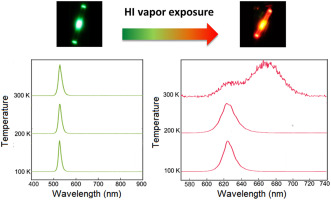Our official English website, www.x-mol.net, welcomes your
feedback! (Note: you will need to create a separate account there.)
Photophysical properties of halide perovskite CsPb(Br1-xIx)3 thin films and nanowires
Journal of Luminescence ( IF 3.3 ) Pub Date : 2020-04-01 , DOI: 10.1016/j.jlumin.2019.116985 D.I. Markina , E. Yu Tiguntseva , A.P. Pushkarev , M.A. Samsonov , M. Vengris , B. Munkhbat , T. Shegai , G.B. Hix , A.A. Zakhidov , S.V. Makarov
Journal of Luminescence ( IF 3.3 ) Pub Date : 2020-04-01 , DOI: 10.1016/j.jlumin.2019.116985 D.I. Markina , E. Yu Tiguntseva , A.P. Pushkarev , M.A. Samsonov , M. Vengris , B. Munkhbat , T. Shegai , G.B. Hix , A.A. Zakhidov , S.V. Makarov

|
Abstract Thin films and nanowires based on lead halide perovskites are promising objects for the design of various optoelectronic devices as well as nano- and microlasers. One of the main advantages of such materials is their absorption and photoluminescence spectra tuning across the visible range via the change in their chemical composition, for instance, by substitution of one halide atom (Br) for another one (I) in the crystal lattice of CsPb(Br1-xIx)3. However, this approach gives materials showing unstable photoluminescence behavior caused by light-induced perovskite phase separation under high-intensity excitation at room temperature. In this work, CsPb(Br1-xIx)3 thin films and nanowires are obtained by chemical vapor anion exchange method from their CsPbBr3 counterparts fabricated by improved wet chemical methods. Spontaneous and stimulated emission from the mixed-halide and pristine bromide samples are studied. Tribromide nanowires exhibit lasing with relatively low thresholds (10–100 μJ/cm2) and high Q-factor of the laser mode up to 3500. The temperature dependence of the photoinitiated phase separation in CsPbBr1.5I1.5 samples is investigated, showing that light-induced phase instability of the mixed-halide nanowires can be suppressed at the somewhat higher temperature (250 K) than the value observed for the thin films having a similar chemical composition. The results obtained are important for the optimization of the functioning of optoelectronic devices based on considered perovskite materials.
中文翻译:

卤化物钙钛矿CsPb(Br1-xIx)3薄膜和纳米线的光物理特性
摘要 基于卤化铅钙钛矿的薄膜和纳米线是用于设计各种光电器件以及纳米和微激光器的有前途的对象。这种材料的主要优点之一是它们的吸收和光致发光光谱通过其化学成分的变化在可见光范围内调谐,例如,通过在晶格中用一个卤化物原子 (Br) 取代另一个 (I) CsPb(Br1-xIx)3。然而,这种方法使材料表现出不稳定的光致发光行为,这是由室温下高强度激发下光诱导钙钛矿相分离引起的。在这项工作中,CsPb(Br1-xIx)3 薄膜和纳米线是通过化学气相阴离子交换方法从其通过改进湿化学方法制造的 CsPbBr3 对应物获得的。研究了混合卤化物和原始溴化物样品的自发和受激发射。三溴化物纳米线表现出具有相对低阈值 (10–100 μJ/cm2) 和高达 3500 的激光模式 Q 因子的激光。研究了 CsPbBr1.5I1.5 样品中光引发相分离的温度依赖性,表明光混合卤化物纳米线的诱导相不稳定性可以在比具有类似化学成分的薄膜观察到的值稍高的温度 (250 K) 下得到抑制。获得的结果对于优化基于钙钛矿材料的光电器件的功能很重要。三溴化物纳米线表现出具有相对低阈值 (10–100 μJ/cm2) 和高达 3500 的激光模式 Q 因子的激光。研究了 CsPbBr1.5I1.5 样品中光引发相分离的温度依赖性,表明光混合卤化物纳米线的诱导相不稳定性可以在比具有类似化学成分的薄膜观察到的值稍高的温度 (250 K) 下得到抑制。获得的结果对于优化基于钙钛矿材料的光电器件的功能很重要。三溴化物纳米线表现出具有相对低阈值 (10–100 μJ/cm2) 和高达 3500 的激光模式 Q 因子的激光。研究了 CsPbBr1.5I1.5 样品中光引发相分离的温度依赖性,表明光混合卤化物纳米线的诱导相不稳定性可以在比具有类似化学成分的薄膜观察到的值稍高的温度 (250 K) 下得到抑制。获得的结果对于优化基于钙钛矿材料的光电器件的功能很重要。表明混合卤化物纳米线的光诱导相不稳定性可以在比具有相似化学成分的薄膜观察到的值稍高的温度 (250 K) 下得到抑制。获得的结果对于优化基于钙钛矿材料的光电器件的功能很重要。表明混合卤化物纳米线的光诱导相不稳定性可以在比具有类似化学成分的薄膜观察到的值稍高的温度 (250 K) 下得到抑制。获得的结果对于优化基于钙钛矿材料的光电器件的功能很重要。
更新日期:2020-04-01
中文翻译:

卤化物钙钛矿CsPb(Br1-xIx)3薄膜和纳米线的光物理特性
摘要 基于卤化铅钙钛矿的薄膜和纳米线是用于设计各种光电器件以及纳米和微激光器的有前途的对象。这种材料的主要优点之一是它们的吸收和光致发光光谱通过其化学成分的变化在可见光范围内调谐,例如,通过在晶格中用一个卤化物原子 (Br) 取代另一个 (I) CsPb(Br1-xIx)3。然而,这种方法使材料表现出不稳定的光致发光行为,这是由室温下高强度激发下光诱导钙钛矿相分离引起的。在这项工作中,CsPb(Br1-xIx)3 薄膜和纳米线是通过化学气相阴离子交换方法从其通过改进湿化学方法制造的 CsPbBr3 对应物获得的。研究了混合卤化物和原始溴化物样品的自发和受激发射。三溴化物纳米线表现出具有相对低阈值 (10–100 μJ/cm2) 和高达 3500 的激光模式 Q 因子的激光。研究了 CsPbBr1.5I1.5 样品中光引发相分离的温度依赖性,表明光混合卤化物纳米线的诱导相不稳定性可以在比具有类似化学成分的薄膜观察到的值稍高的温度 (250 K) 下得到抑制。获得的结果对于优化基于钙钛矿材料的光电器件的功能很重要。三溴化物纳米线表现出具有相对低阈值 (10–100 μJ/cm2) 和高达 3500 的激光模式 Q 因子的激光。研究了 CsPbBr1.5I1.5 样品中光引发相分离的温度依赖性,表明光混合卤化物纳米线的诱导相不稳定性可以在比具有类似化学成分的薄膜观察到的值稍高的温度 (250 K) 下得到抑制。获得的结果对于优化基于钙钛矿材料的光电器件的功能很重要。三溴化物纳米线表现出具有相对低阈值 (10–100 μJ/cm2) 和高达 3500 的激光模式 Q 因子的激光。研究了 CsPbBr1.5I1.5 样品中光引发相分离的温度依赖性,表明光混合卤化物纳米线的诱导相不稳定性可以在比具有类似化学成分的薄膜观察到的值稍高的温度 (250 K) 下得到抑制。获得的结果对于优化基于钙钛矿材料的光电器件的功能很重要。表明混合卤化物纳米线的光诱导相不稳定性可以在比具有相似化学成分的薄膜观察到的值稍高的温度 (250 K) 下得到抑制。获得的结果对于优化基于钙钛矿材料的光电器件的功能很重要。表明混合卤化物纳米线的光诱导相不稳定性可以在比具有类似化学成分的薄膜观察到的值稍高的温度 (250 K) 下得到抑制。获得的结果对于优化基于钙钛矿材料的光电器件的功能很重要。











































 京公网安备 11010802027423号
京公网安备 11010802027423号